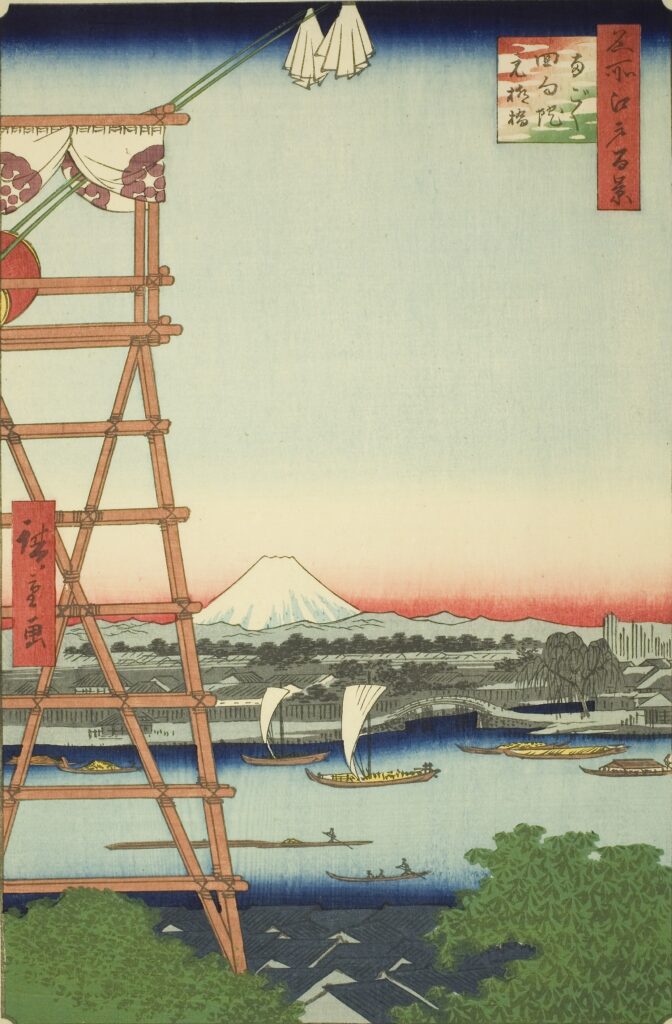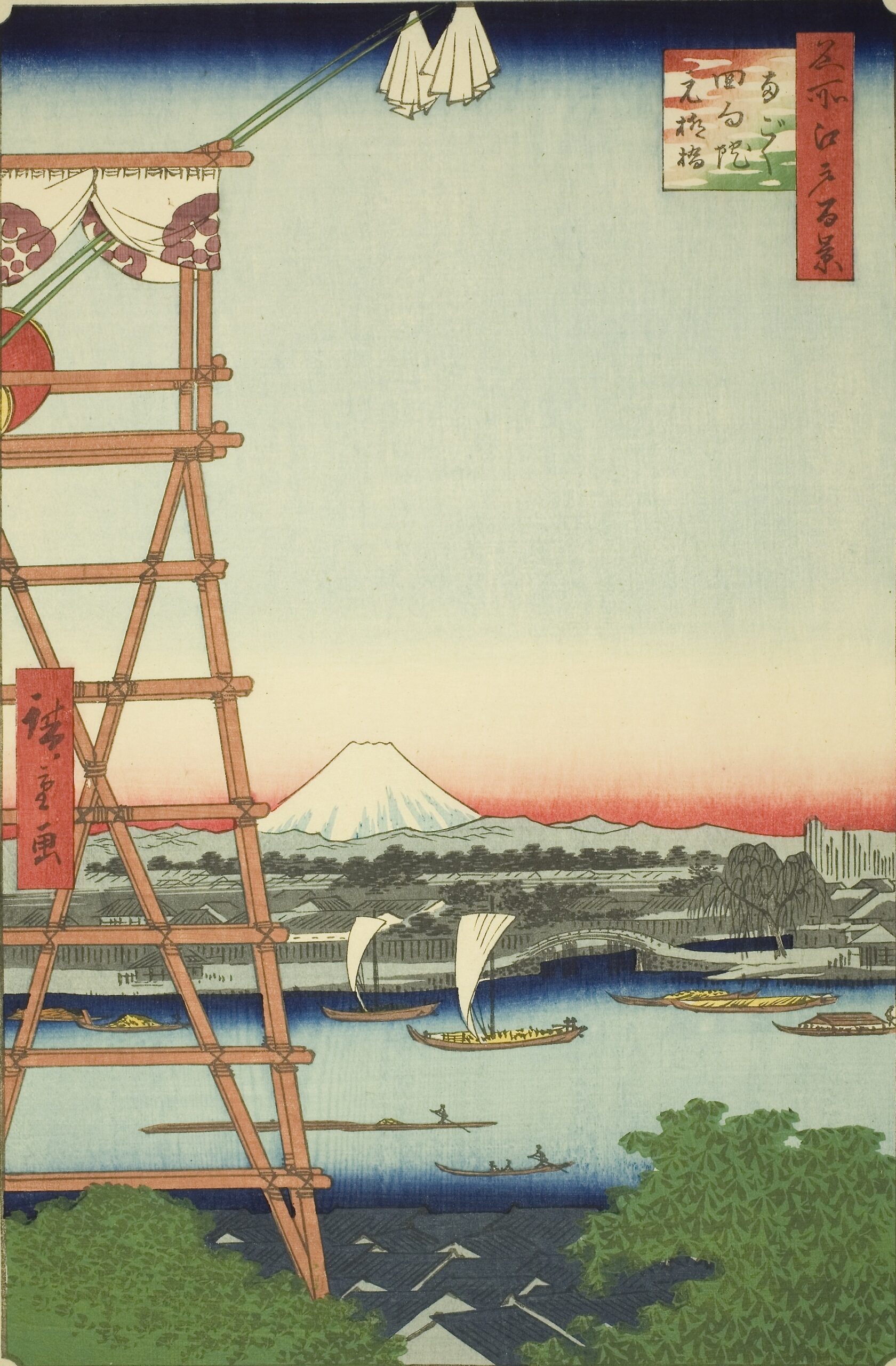
Utagawa Hiroshige – One Hundred Famous Views of Edo – 5 – Spring – Ryogoku Ekoin Temple and Yanagibashi Bridge 歌川広重-名所江戸百景-5-春-両ごく回向院元柳橋 解説
Current Address: Ekoin Temple, Ryogoku 2-chome, Sumida Ward
Latitude and Longitude: Latitude 35.6949, Longitude 139.7932
Published: May 1857 Age: 61
Explanation
<1> Introduction
“Ryogoku Ekoin Temple and Yanagibashi Bridge” is based on Ekoin Temple, located in the Ryogoku area on the east bank of the Sumida River, and the surrounding Yanagibashi area.
For the people of Edo, Ekoin Temple was not only a place of worship, but also a bustling area adjacent to the entertainment district around Ryogoku Bridge.
<2> About Ekoin Temple and Yanagibashi Bridge
Ekoin Temple was built in 1659 to commemorate the tens of thousands of victims who died in the Great Fire of Meireki.
The Meireki Fire broke out at Honmyo-ji Temple in Maruyama-cho, Hongo, on New Year’s Day in 1657.
The fire destroyed over 400 neighborhoods, killed over 100,000 people, and destroyed the main keep of Edo Castle.
This temple was built as a memorial service for the common people following the largest disaster in Edo.
The vast grounds were a spiritual refuge for the common people of Edo.
It was also known for animal memorial services, and the remaining monuments to elephants and dogs demonstrate its deep devotion.
Located at the foot of Ryogoku Bridge, it was constantly busy with people, making it popular for both religious and leisure activities.
Yanagibashi Bridge was built during the Kan’ei era, where the Kanda River flows into the Sumida River.
It came to be called “Yanagibashi” (Willow Bridge) because of the many willow trees planted along the riverside.
In the late Edo period, Yanagibashi developed into a red-light district.
Although smaller in scale than Asakusa Shin-Yoshiwara, it possessed a refined atmosphere and was beloved by literati, artists, and connoisseurs.
Enjoying boating here and hosting banquets accompanied by geisha was considered the pinnacle of Edo.
It was also a shipping hub on the Sumida River, giving rise to the “boating culture” of boats arriving directly at restaurants.
A fire broke out at Honmyoji Temple in Hongo-Maruyama-cho on New Year’s Day in 1657, destroying over 400 neighborhoods, killing over 100,000 people, and destroying the inner citadel of Edo Castle.
<3> Highlights of the Painting
The painting shows a vast expanse of river, with Yanagibashi Bridge and the Ekoin Temple building spanning the river.
Hiroshige boldly depicts the waterfront space, expressing the open, spacious landscape of Edo.
On one side are the Ekoin Temple buildings, and on the other are restaurants and rows of willow trees.
The contrast between Edo’s unique streetscape, where faith and entertainment coexist, is intriguing.
The boats passing on the river and the people walking along the riverbank exude a sense of the daily lives of Edo commoners.
It’s clear that Hiroshige wasn’t just a painter of famous places, but a landscape painter who conveyed the breath of the people.
The large river in front is the Sumida River. The two boats in the center are Takase-bune boats. There is a raft in the lower left.
The arched bridge in the center is Motoyanagibashi Bridge. Numerous willow trees can be seen beyond Motoyanagibashi Bridge.
Motoyanagibashi Bridge was originally called Yanagibashi Bridge.
The bridge north of this bridge at the mouth of the Kanda River was also named Yanagibashi Bridge, hence the name Motoyanagibashi Bridge.
The drum on the large tower on the left was played in the morning and at the end of sumo matches.
<4> The appeal felt by Edo commoners
For Edo commoners, who lived side by side with fires, famine, and epidemics, visiting Ekoin Temple was an important practice that helped them to calm their minds.
The area around Ryogoku Bridge over the Sumida River was a red-light district lined with fireworks displays and sideshow booths.
Just a short walk from Ekoin Temple was “Edo’s greatest entertainment space.”
Yanagibashi was not a large-scale red-light district like Yoshiwara, but a place where you could enjoy sophisticated riverside entertainment.
Boating and banquets at traditional Japanese restaurants were also places of pride for connoisseurs.
<5> Ekoin Temple and Yanagibashi Today
Ekoin Temple still stands near Ryogoku Station, and within its grounds you’ll find a monument related to sumo and a memorial tower for animals.
It’s an easy spot to visit, along with the Ryogoku Kokugikan Sumo Hall.
The Yanagibashi area has lost its former glory.
Yanagibashi Bridge, spanning the confluence of the Kanda and Sumida Rivers, has been restored and is dotted with traditional Japanese restaurants and Japanese cuisine.
You can evoke the atmosphere of the Edo period.
From the riverside promenade of Sumida River Terrace, you can enjoy a waterfront view just like in Hiroshige’s paintings.
We recommend a stroll at dusk.
<6> Tourist Guide
1. Visit Ekoin Temple
Walk through the quiet temple grounds while learning about the history of this temple, which enshrines the victims of the Great Edo Fire.
2. Ryogoku Kokugikan
Experience Edo-era entertainment and modern sumo culture all at once.
3. Dine at a Ryotei in the Yanagibashi Area
Relive the culture of boat transport at a long-established restaurant that preserves the elegance of Edo.
4. Riverside Stroll
The view from the confluence of the Sumida and Kanda rivers is spectacular.
Walking with a painting by Hiroshige in hand will leave you feeling even more moved.


